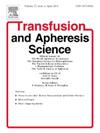Efficacy of Ruxolitinib in the management of chronic GVHD
IF 1.4
4区 医学
Q4 HEMATOLOGY
引用次数: 0
Abstract
Objectives
Allogeneic hematopoietic stem cell transplantation (allo-HSCT) is a potentially curative treatment for hematological diseases, with success rates improving due to advancements in conditioning regimens and new anti-graft versus host disease (GVHD) drugs. Ruxolitinib, an oral selective Janus kinase (JAK) 1 and 2 inhibitor has been used to mitigate the effects of various inflammatory and myeloproliferative syndromes, given the JAK kinase pathway's central role in cytokine signaling during inflammatory and immune processes. In this study we aimed to assess ruxolitinib's efficacy in patients with chronic GVHD (cGVHD).
Material and methods
This retrospective observational multi-center study involved 50 patients diagnosed with cGVHD after allo-HSCT in Turkey, who were treated with ruxolitinib between April 2018 and March 2024.
Results
At the time of initiation of ruxolitinib treatment, most patients had severe cGVHD (n = 29, 58 %). The overall response rate at 6 months of ruxolitinib treatment was observed in 34 patients (68 %), including 6 patients (12 %) with complete responses and 28 patients (56 %) with partial responses, while 7 patients (14 %) experienced treatment failure. ECOG (2−4) performance status was established as an independent risk factor for adverse outcomes [p = 0.029, HR 3.492 (95 % CI: 1.139–10.705)]. At the two-year follow-up, the estimated survival rate was 52 %.
Conclusion
Ruxolitinib is safe and effective in the real-world setting for treating cGVHD, showing remission rates comparable to clinical trials. Further research with extended follow-up is necessary to confirm these findings, optimize dosing, and establish the best tapering strategies for responders.
鲁索利替尼治疗慢性GVHD的疗效观察。
目的:同种异体造血干细胞移植(Allogeneic hematopoietic stem cell transplantation, alloo - hsct)是一种治疗血液病的潜在治疗方法,由于调节方案的进步和新的抗移植物抗宿主病(GVHD)药物,其成功率不断提高。Ruxolitinib是一种口服选择性Janus激酶(JAK) 1和2抑制剂,已被用于减轻各种炎症和骨髓增生综合征的影响,因为JAK激酶途径在炎症和免疫过程中细胞因子信号传导中起核心作用。在这项研究中,我们旨在评估ruxolitinib对慢性GVHD (cGVHD)患者的疗效。材料和方法:这项回顾性观察性多中心研究纳入了50例在土耳其接受同种异体造血干细胞移植后诊断为cGVHD的患者,这些患者在2018年4月至2024年3月期间接受了鲁索利替尼治疗。结果:ruxolitinib治疗开始时,大多数患者为重度cGVHD (n = 29,58 %)。34例患者(68 %)在ruxolitinib治疗6个月时观察到总缓解率,其中6例患者(12 %)完全缓解,28例患者(56 %)部分缓解,7例患者(14 %)治疗失败。ECOG(2-4)表现状态被确定为不良结局的独立危险因素[p = 0.029,HR 3.492(95 % CI: 1.139-10.705)]。在两年的随访中,估计存活率为52% %。结论:Ruxolitinib在治疗cGVHD的现实环境中是安全有效的,其缓解率与临床试验相当。有必要进行进一步的研究,延长随访时间,以证实这些发现,优化剂量,并为应答者建立最佳的逐渐减少策略。
本文章由计算机程序翻译,如有差异,请以英文原文为准。
求助全文
约1分钟内获得全文
求助全文
来源期刊
CiteScore
3.60
自引率
5.30%
发文量
181
审稿时长
42 days
期刊介绍:
Transfusion and Apheresis Science brings comprehensive and up-to-date information to physicians and health care professionals involved in the rapidly changing fields of transfusion medicine, hemostasis and apheresis. The journal presents original articles relating to scientific and clinical studies in the areas of immunohematology, transfusion practice, bleeding and thrombotic disorders and both therapeutic and donor apheresis including hematopoietic stem cells. Topics covered include the collection and processing of blood, compatibility testing and guidelines for the use of blood products, as well as screening for and transmission of blood-borne diseases. All areas of apheresis - therapeutic and collection - are also addressed. We would like to specifically encourage allied health professionals in this area to submit manuscripts that relate to improved patient and donor care, technical aspects and educational issues.
Transfusion and Apheresis Science features a "Theme" section which includes, in each issue, a group of papers designed to review a specific topic of current importance in transfusion and hemostasis for the discussion of topical issues specific to apheresis and focuses on the operators'' viewpoint. Another section is "What''s Happening" which provides informal reporting of activities in the field. In addition, brief case reports and Letters to the Editor, as well as reviews of meetings and events of general interest, and a listing of recent patents make the journal a complete source of information for practitioners of transfusion, hemostasis and apheresis science. Immediate dissemination of important information is ensured by the commitment of Transfusion and Apheresis Science to rapid publication of both symposia and submitted papers.

 求助内容:
求助内容: 应助结果提醒方式:
应助结果提醒方式:


